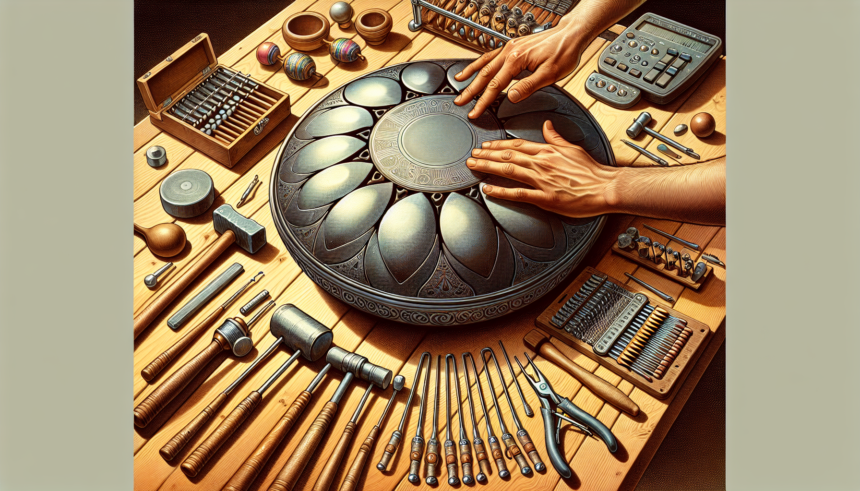Handpans, known for their unique and serene timbre, have garnered significant attention from musicians and enthusiasts alike. These instruments, which blend the percussive and melodic nature of drums and bells, require careful crafting and precise tuning to achieve their distinctive sound. Tuning a handpan is both an art and a science, involving specific tools and techniques to ensure each note rings out perfectly. This article delves into the basics of handpan tuning, covering essential tools, common techniques, and key considerations for prospective and current owners of these captivating instruments.
Understanding Handpan Structure
Before venturing into the specifics of tuning, it’s essential to understand the physical structure of a handpan. Handpans are typically made from two hemispherical steel shells, adhered together to form a resonant chamber. The top shell, or “dome,” features a central note called the “ding” and several tone fields arranged around it.
Each tone field is meticulously crafted and tuned to produce a specific pitch, harmonic, and overtone. The fundamental frequency of a tone field is accompanied by its octave and a fifth, creating a rich and full sound. This intricate structure demands precision in both the initial creation and subsequent tuning processes.
Essential Tools for Handpan Tuning
Tuning a handpan requires a range of specialized tools to ensure accuracy and consistency. Here are some of the most essential items:
Tuning Hammers
Tuning hammers are critical for adjusting the pitch of each tone field. These hammers come in various sizes and shapes, allowing for precise control over the force applied to the steel. Typically, tuners use a set of hammers with different heads, such as nylon, wooden, or metal, depending on the desired effect and the specific material characteristics of the handpan.
Electronic Tuner
An electronic tuner is indispensable for identifying the exact pitch of each note. These devices help tuners make minute adjustments to ensure the handpan’s tone fields are perfectly aligned with their intended frequencies. Some tuners prefer using software-based tuners on their computers or smartphones, while others opt for dedicated hardware units.
Stroboscope
A stroboscope is a sophisticated tuning tool that provides a visual representation of the instrument’s pitch. By shining a strobe light onto the vibrating handpan, tuners can observe changes in the light’s reflection pattern to make precise adjustments. This level of detail is particularly useful for fine-tuning harmonics and overtones.
Sandbags and Supports
Keeping the handpan stable during the tuning process is crucial. Sandbags or specialized supports help secure the instrument in place, ensuring that each adjustment is made accurately without unintended movement. Proper stabilization also minimizes the risk of damaging the handpan during tuning.
Common Handpan Tuning Techniques
With the right tools in hand, tuners employ various techniques to achieve the perfect sound. Here are some of the most common methods used in handpan tuning:
Shaping and Forming
The initial shaping and forming of the handpan involve manipulating the metal to create the desired note areas. This process typically requires hammering the steel into rough shapes, followed by more precise adjustments to define the tone fields. Achieving the correct shape is foundational for accurate tuning later on.
Pushing and Pulling
Once the basic shape is established, tuners use pushing and pulling techniques to fine-tune the pitch of each tone field. Pushing involves gently forcing the steel inward, thereby raising the pitch, while pulling entails pushing the steel outward to lower the pitch. These adjustments are made incrementally, with tuners frequently referring to their electronic tuners or stroboscopes to check the resulting pitch changes.
Fine-Tuning Harmonics
Adjusting the fundamental pitch is only part of the equation; achieving a well-tuned handpan also requires fine-tuning the harmonics and overtones associated with each note. This process involves minor adjustments to the steel’s surface and contour, ensuring that the octave and fifth harmonics align correctly with the fundamental frequency. Expert tuners have developed an acute sensitivity to these sonic nuances, allowing them to craft instruments with exceptionally clear and resonant sounds.
Annealing and Stress Relieving
Throughout the tuning process, the steel undergoes significant physical changes, leading to built-up stress within the material. Annealing and stress-relieving techniques involve heating the handpan to specific temperatures and allowing it to cool gradually. This treatment helps alleviate internal stresses, stabilizing the metal and locking in the tonal adjustments made during tuning. Properly annealed handpans retain their tuning more effectively and are less prone to deformation over time.
Considerations for Handpan Tuners
Material Quality
The quality of the steel used in handpan construction has a profound impact on the instrument’s tunability and overall sound quality. High-grade steel, often treated with nitriding processes to enhance its durability and resonance, provides a more stable and consistent platform for tuning. Tuners must be familiar with the material characteristics to make appropriate adjustments and achieve the desired tonal outcomes.
Environmental Factors
Environmental conditions such as temperature and humidity can influence a handpan’s tuning stability. Extreme changes in these factors can cause the steel to expand or contract, potentially altering the pitch of the tone fields. Tuners must take these variables into account, often working in climate-controlled environments to ensure consistent results. For handpan owners, regular tuning checks and proper storage conditions are essential for maintaining the instrument’s sound quality.
Experience and Skill
Tuning a handpan demands a high level of skill and experience. Master tuners often spend years honing their craft, developing an intuitive understanding of how different factors interact to shape the instrument’s sound. Novice tuners should approach the process with patience and a willingness to learn, gradually building their expertise through practice and careful observation.
Conclusion
The intricate art of handpan tuning blends technical precision with a deep appreciation for the instrument’s acoustic properties. From selecting the right tools to mastering various shaping and fine-tuning techniques, tuners play a crucial role in bringing out the best in these mesmerizing instruments. While the process is complex and demanding, the reward of creating a beautifully resonant handpan is well worth the effort. For musicians and enthusiasts, understanding the basics of handpan tuning enhances their appreciation of the craftsmanship involved and provides valuable insights into maintaining their instruments in top condition.
FAQs
1. How often should a handpan be tuned?
Handpans typically need tuning every 1-2 years, depending on usage and environmental factors. Regular checks can help identify any pitch changes early, allowing for timely adjustments.
2. Can I tune my handpan myself, or should I seek a professional?
While it’s possible to learn handpan tuning, it requires significant skill and experience. Beginners should consider seeking a professional tuner to avoid damaging the instrument. As experience grows, more advanced tuners may successfully perform their own adjustments.
3. What should I do if my handpan sounds out of tune?
If your handpan sounds off, consult a professional tuner to assess and correct the issue. Avoid making hasty adjustments yourself, as improper techniques can compromise the instrument’s integrity.
4. How can I protect my handpan from environmental damage?
Store your handpan in a case and keep it in a stable environment with moderate temperature and humidity levels. Avoid exposure to direct sunlight, extreme temperatures, and moisture to preserve tuning stability.
5. Are there different tuning scales available for handpans?
Yes, handpans can be tuned to various scales, including major, minor, and exotic scales. The choice of scale affects the instrument’s tonal character and versatility, catering to different musical preferences and styles.





